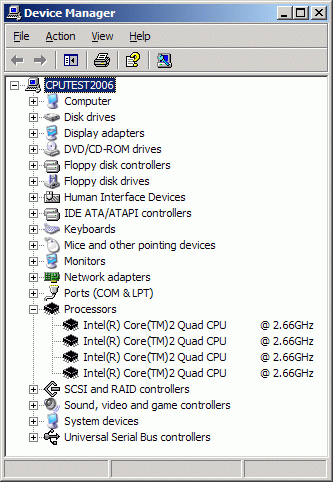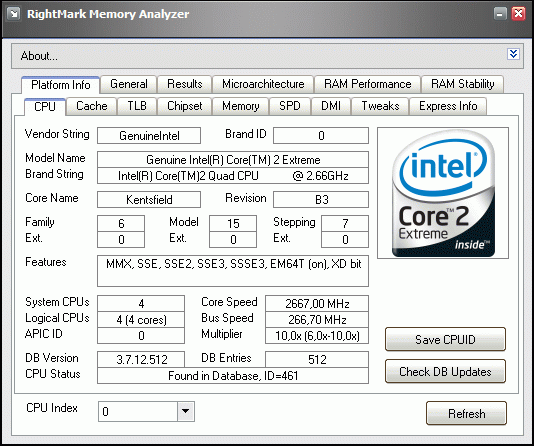 |
||
|
||
| ||
We have long been used to various supermarkets and megamalls, so we are not surprised if a pair of shampoo bottles or tooth-paste packs glued together are sold for the price of one. Today Intel, the owner of the largest processor supermarket, is making us a similar offer: a pair of Core 2 Duo E6700 CPUs, well, not for the price of one, but glued together nevertheless. So, let's take a closer look at what "lies beneath", and what we should do with it. A quad-core processor of Core 2 eXtreme series marked QX6700 actually features two Core 2 Duo E6700 dies assembled in a single body. Remember that please: two dies, not one. We couldn't bring ourselves to break the processor, but its cache organization is an indirect evidence to this fact: instead of following the tradition and making a large shared L2 for all cores, Intel provided each couple of dies with 4MB of cache shared exclusively by that couple. All other features of QX6700 follow from its organization: doubled cores and total L2, everything else is the same as Core 2 Duo E6700. Accordingly, our expectations were formulated prior to benchmarking itself: we were to observe the struggle between higher clock rate (of Core 2 eXtreme X6800) and doubled cores at some lower frequency (of Core 2 eXtreme QX6700). Core architecture, features, etc. were completely identical. But we thought that wasn't enough and conducted another experiment. Since Intel's engineering samples had unlocked multiplier, we tried to have a look at the future and overclocked our QX6700 to 2.93 GHz (by changing multiplier from x10 to x11) and then to 3.2 GHz (x12). Strangely enough, processor behaved all right and showed good stability at higher clock rates even without overvoltaging and other overclocker tricks. Of course, this experiment has only theoretical meaning, since Intel might have change core steppings (or something else), when these processors are actually released. But just for your information we provided these results as well.
 
Hardware and softwareTestbeds
* - The complete code: BX97520J.86A.1024.2006.0814.1142
* - "2 x ..." means per core Software
Drivers
BenchmarkingEssential foreword to chartsOur test procedure features two peculiarities of data representation: (1) all data types are reduced to one - integer relative score (performance of a given processor relative to that of Pentium D 805, given its performance is 100 points), and (2) detailed results are published in a Microsoft Excel table, while the article contains only summary charts by benchmark classes. 3D Modelling & RenderingIf you open the detailed results table, you will notice that QX6700 had to struggle enough for its general victory. According to interactive subtests, it loses to X6800, and even E6700. While the first can be explained by lower clock rate, the second is not that clear: why should 2 x E6700 be slower than 1 x E6700? From the point of pure theory we can assume that additional switch, which enables two die sets to share the same bus, introduces additional delays affecting, most likely, memory access latency. The rendering performance of QX6700 however allowed it to disregard all annoying particulars and win absolutely and impressively. CAD & CAEAnd here we, most likely, are seeing the aforementioned disadvantage and no advantages. We are always surprised why serious applications like Matlab, Pro/ENGINEER and SolidWorks still cannot make use of multi-processor configurations. Anyway, these suites fully disregarded the presence of four cores. Note that QX6700 (both normal and overclocked) always performs slightly worse than dual-core processors of the same clock rate (E6700 and X6800). CompilingIn our case compiling wasn't multi-threaded, so the result was obvious even prior to the tests. And again note some defect or imperfection of die sets interface: QX6700 is slightly slower than E6700, though it shouldn't be so. The same thing with QX6700 and X6800 operating at 2.93 GHz. RightMarkThese results were easy to predict. And again QX6700 profited by rendering performance. (CPU RightMark supports up to 16-way configurations in that module.) Photo ProcessingAdobe Photoshop CS2 was a nice surprise. Frankly speaking, we didn't expect such a proper support for multi-processor configurations. Web ServerBad, bad, bad... Considering the kind of load this test creates, we are nearly sure that QX6700 was greatly bottlenecked by memory access latency. It seems 4 core coupled with 2-level switching is too awkward for some tasks. ArchivingYou can clearly see that 7-zip can't use more than 2 cores. E6700 and QX6700 as well as X6800 and QX6700 @ 2.93 GHz performed nearly the same. Audio EncodingCore 2 eXtreme QX6700 almost caught up with E6700. Considering the aforementioned issues, this is nice already. Video EncodingIf you take a look at detailed results, you will see that QX6700 wins due to DivX and x264 subtests. Obviously, these two codecs have the most "honest" multi-processor optimization, i.e. support more than 2 cores. Text RecognitionQX6700 performed the same as E6700. Reasons are obvious, comments not needed. 3D GamesQX6700 is slightly slower than E6700. Like always, we have to relate this to assumptions we made earlier. But the lag is not critical anyway. Total ScoreEfficiency Per GHzConclusionsSo, let's draw a bottom line. As a matter of admiration Intel Core 2 eXtreme QX6700 is surely impressive. Four cores in a single body; 8 MB of L2 cache in total (you could even work in Windows 95 with that amount of RAM!); nearly utmost clock rate for the moment; some fantastic test results... Yes, exactly some. Not all, that's for sure. And not even all related to dual-core operation. Because the support for multi-processor and dual-processor configurations naturally turned out to have different meanings. Some formally multi-way applications ("multi" means more than one in this case) can't effectively support more than two CPUs. Therefore, as a matter of perplexity Core 2 eXtreme QX6700 provokes one natural question: "What is it for?" To showcase Intel's technical potential? Undoubtedly. By the way, this is pretty obvious: boast, if you have something worthy. This task is accomplished. To provide users of a relatively small group of applications with a more "extreme" processor? This is accomplished as well. But the usability became narrower. Looking at how slowly software developers are mastering dual-core support that came like a bolt from the blue, we can assume that quad-core support will be implemented in the even more distant future. Besides, many developers think it's ok to implement "partial" multi-way support, instead of its fully-fledged variant (16-way, for example). The average score we obtained proves it all right. According to it, a usual dual-core Core 2 eXtreme X6800 is generally faster than QX6700 in the mix of single- and multi-threaded applications. X6800 still has lower "professional" average score that reflects "serious" resource-intensive applications. And that's right: exactly this software requires a 4-core or 4-processor machine.
P.S. We were really impressed by engineering sample overclockability to 3.2 GHz without overvoltaging and other fine-tuning tricks. There's a high probability that Intel is already capable of producing such processors (even in scanty quantities). And this seems to be the most alarming matter for its rival, as AMD will hardly be able to oppose to Intel Core 3.2 GHz quad-core high-end desktop and workstation solution in the nearest future. Memory modules for testbeds were kindly provided by
Corsair Memory Russia Stanislav Garmatyuk (nawhi@ixbt.com) November 2, 2006 Write a comment below. No registration needed!
|
Platform · Video · Multimedia · Mobile · Other || About us & Privacy policy · Twitter · Facebook Copyright © Byrds Research & Publishing, Ltd., 1997–2011. All rights reserved. |